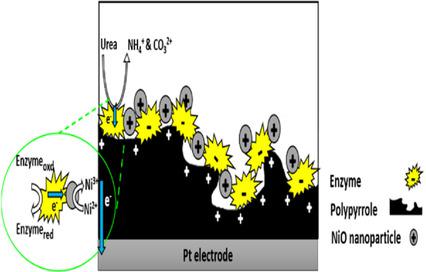当前位置:
X-MOL 学术
›
Electroanalysis
›
论文详情
Our official English website, www.x-mol.net, welcomes your
feedback! (Note: you will need to create a separate account there.)
A Novel Bioelectrochemical Sensor Based on Immobilized Urease on the Surface of Nickel Oxide Nanoparticle and Polypyrrole Composite Modified Pt Electrode
Electroanalysis ( IF 2.7 ) Pub Date : 2019-11-19 , DOI: 10.1002/elan.201800862 Maliheh Hosseinian 1 , Ghasem Najafpour Darzi 1 , Ahmad Rahimpour 1
Electroanalysis ( IF 2.7 ) Pub Date : 2019-11-19 , DOI: 10.1002/elan.201800862 Maliheh Hosseinian 1 , Ghasem Najafpour Darzi 1 , Ahmad Rahimpour 1
Affiliation

|
Nickel oxide nanoparticle (NiO−NP) and polypyrrole (PPy) composite were deposited on a Pt electrode for fabrication of a urea biosensor. To develop the sensor, a thin film of PPy−NiO composite was deposited on a Pt substrate that serves as a matrix for the immobilization of enzyme. Urease was immobilized on the surface of Pt/PPy−NiO by a physical adsorption. The response of the fabricated electrode (Pt/PPy−NiO/Urs) towards urea was analyzed by chronoamperometry and cyclic voltammetry (CV) techniques. Electrochemical response of the bio‐electrode was significantly enhanced. This is due to electron transfer between Ni2+ and Ni3+ as the electro‐catalytic group and the reaction between polypyrrole and the urease‐liberated ammonium. The fabricated electrode showed reliable and demonstrated perfectly linear response (0.7–26.7 mM of urea concentration, R2= 0.993), with high sensitivity (0.153 mA mM−1 cm−2), low detection of limit (1.6 μM), long stability (10 weeks), and low response time (∼5 s). The developed biosensor was highly selective and obtained data were repeatable and reproduced using PPy‐NiO composite loaded with immobilized urease as urea biosensors.
中文翻译:

基于氧化镍纳米粒子表面固定化脲酶和聚吡咯复合修饰Pt电极的新型生化传感器
氧化镍纳米颗粒(NiO-NP)和聚吡咯(PPy)复合材料沉积在Pt电极上,用于制造尿素生物传感器。为了开发传感器,将PPy-NiO复合材料薄膜沉积在Pt基板上,该基板用作固定酶的基质。脲酶通过物理吸附固定在Pt / PPy-NiO的表面上。通过计时安培法和循环伏安法(CV)技术分析了制成的电极(Pt / PPy-NiO / Urs)对尿素的响应。生物电极的电化学反应显着增强。这是由于Ni 2+和Ni 3+之间的电子转移作为电催化基团,以及聚吡咯与脲酶释放的铵之间的反应。制成的电极显示出可靠的性能,并表现出完美的线性响应(尿素浓度为0.7–26.7 mM,R 2 = 0.993),灵敏度高(0.153 mA mM -1 cm -2),极限检测值低(1.6μM),稳定性高(10周),反应时间短(〜5 s)。研发的生物传感器具有很高的选择性,使用固定化脲酶的PPy-NiO复合材料作为尿素生物传感器,可以重复和复制获得的数据。
更新日期:2019-11-20
中文翻译:

基于氧化镍纳米粒子表面固定化脲酶和聚吡咯复合修饰Pt电极的新型生化传感器
氧化镍纳米颗粒(NiO-NP)和聚吡咯(PPy)复合材料沉积在Pt电极上,用于制造尿素生物传感器。为了开发传感器,将PPy-NiO复合材料薄膜沉积在Pt基板上,该基板用作固定酶的基质。脲酶通过物理吸附固定在Pt / PPy-NiO的表面上。通过计时安培法和循环伏安法(CV)技术分析了制成的电极(Pt / PPy-NiO / Urs)对尿素的响应。生物电极的电化学反应显着增强。这是由于Ni 2+和Ni 3+之间的电子转移作为电催化基团,以及聚吡咯与脲酶释放的铵之间的反应。制成的电极显示出可靠的性能,并表现出完美的线性响应(尿素浓度为0.7–26.7 mM,R 2 = 0.993),灵敏度高(0.153 mA mM -1 cm -2),极限检测值低(1.6μM),稳定性高(10周),反应时间短(〜5 s)。研发的生物传感器具有很高的选择性,使用固定化脲酶的PPy-NiO复合材料作为尿素生物传感器,可以重复和复制获得的数据。











































 京公网安备 11010802027423号
京公网安备 11010802027423号